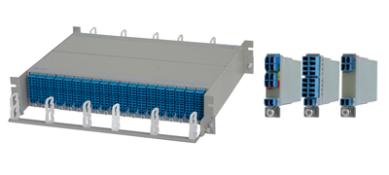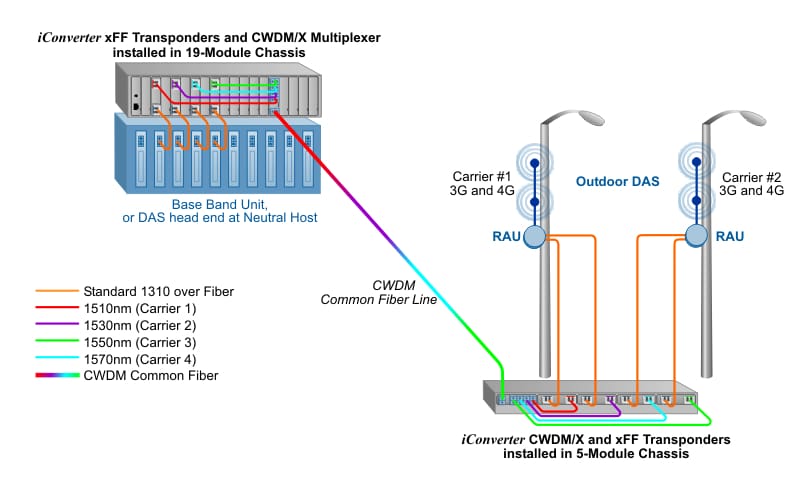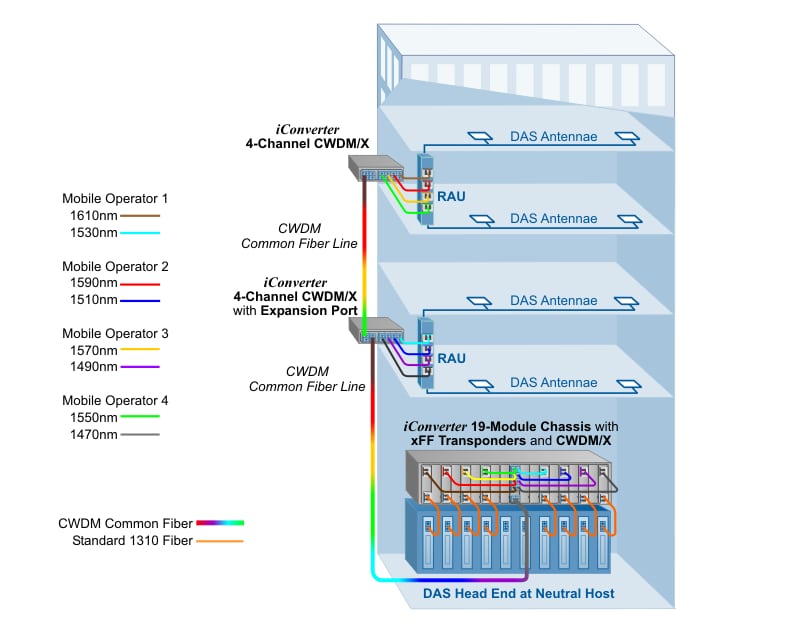Overview
Expanding Cell Coverage with DAS
The proliferation of smart devices in high-density urban areas like high-rises, sports arenas and university campuses is creating challenges to provide coverage to all users.
To expand wireless coverage and reduce infrastructure costs, Mobile Network Operators (MNO) are working with Neutral Host providers and facility owners to deploy Heterogeneous Networks (HetNet) and Cloud-RAN (C-RAN) networks that include Distributed Antenna Systems (DAS). “Black holes” and “Not Spots” inside buildings and outside of cell tower coverage areas can be served with DAS.
Neutral Host operators can establish a DAS head end at a central location in the campus for connectivity to multiple MNOs with Base Band Units (BBU), or deploy multiple head ends in each DAS location. The wireless services are distributed from the DAS head end to different indoor and outdoor DAS locations over DAS fronthaul fiber networks.
The technical challenges with DAS deployments are high equipment costs, and DAS fronthaul infrastructure costs associated with connecting multiple operators to DAS from the head end or BBU. Omnitron’s CWDM Multiplexers expand fiber network capacity, and protocol transparent transponders enable connectivity between multiplexers most network equipment.
Products
DAS Fronthaul Products
iConverter® CWDM Multiplexers

iConverter CWDM Multiplexers are part of the iConverter Multi-Service Platform and used to deliver multiple services across a CWDM DAS fronthaul link. iConverter CWDM MUX/DEMUX modules and Optical Add and Drop modules can be installed in a variety of compact and high-density chassis.
iConverter xFF Transponders
![]()
iConverter xFF Transponders are protocol-transparent fiber-to-fiber media converters, and are available as compact, unmanaged standalone units or a managed chassis plug-in modules. The iConverter xFF provides reliable and cost-effective conversion between different wavelengths using Omnitron’s CWDM SFP Transceivers.
Outdoor DAS CWDM Fronthaul Application
Expanding DAS Fronthaul Fiber Capacity with CWDM
This Distributed Antenna Systems (DAS) application example illustrates how to overcome fiber capacity challenges by transporting four wireless services over a DAS fronthaul fiber link using Coarse Wavelength Division Multiplexing (CWDM). Omnitron’s iConverter CWDM/X Multiplexers and xFF Transponders enable CWDM connectivity from a DAS head end to Remote Access Units (RAU).
Reduce DAS deployment costs by transporting multiple data channels over fronthaul fiber links
The DAS head end or Base Band Unit is located at a Neutral Host location on the campus, as shown in the upper left of the diagram. The fiber ports on the line cards in the DAS head end support standard 1310 wavelengths. Each line card supports a different mobile operator. Fiber patch cables connect the DAS head end line cards to iConverter xFF Transponders installed in a high-density 19-Module Chassis. The four xFF Transponders convert the fiber from standard wavelengths to CWDM wavelengths with Small Form Pluggable (SFP) transceivers. Standard wavelength SFPs and CWDM wavelength SFPs are installed in each of the xFF Transponders. The CWDM SFPs support specific wavelengths to enable connectivity to the matching channel ports on the iConverter CWDM/X multiplexer with fiber patch cables (shown in different colors to represent the CWDM wavelengths). Omnitron’s CWDM transceivers have color-coded latch handles for easy identification. The CWDM/X multiplexes the four wavelengths over the CWDM Common Fiber Line that connects the Neutral Host location to the Outdoor DAS Radio Access Units (RAU) installed on light poles.

At the outdoor DAS remote end of the CWDM common fiber link, a 5-Module Chassis is populated with matching CWDM/X multiplexer and xFF Transponder modules that enable connectivity between the CWDM channel ports and the standard wavelength connectors on the RAU equipment that are deployed in the DAS.
This architecture enables multiple services to be transported to a DAS remote location over existing fiber infrastructure.
Indoor DAS CWDM Fronthaul Application
Expanding Fiber Capacity with CWDM for Indoor DAS Connectivity
This Distributed Antenna Systems (DAS) application example illustrates how to overcome the fiber capacity challenge and transport eight wireless circuits for four mobile operators over a fiber link to two distinct Remote Access Units (RAU) using CWDM. Omnitron’s iConverter CWDM/X Multiplexers and xFF Transponders enable CWDM connectivity over existing fiber in the hi-rise building.
The DAS head or Base Band Unit end is located in the ground floor of the building (The Neutral Host location on the campus). The line cards in the DAS head end provide connectivity for the four mobile operators, each with a circuit connecting to two DAS Radio Access Units (RAU). The fiber ports on the line cards in the DAS head end support standard 1310 wavelengths. Fiber patch cables connect the DAS head end line cards to eight iConverter xFF Transponders installed in a high-density 19-Module Chassis.

The xFF Ttransponders convert the fiber with standard wavelengths to CWDM wavelengths with standard wavelength SFPs and CWDM wavelength SFPs. The CWDM SFPs support specific wavelengths to enable connectivity to the eight matching channel ports on the iConverter CWDM/X multiplexer with fiber patch cables (shown in different colors to represent the CWDM wavelengths).
The CWDM/X multiplexes the eight wavelengths over the CWDM Common Fiber Line that connects the Neutral Host location to the two distinct indoor DAS RAUs.
The CWDM Common Fiber Line runs up the building to an iConverter 4-Channel CWDM/X MUX with an Expansion Port installed on the second floor. The CWDM/X drops off four channels at this location that transport 4G/LTE from four different mobile operators. The Expansion port passes the four other channels up to the CWDM/X MUX on the fourth floor, where four more services are handed off to the RAU, expanding coverage to the top two floors.
This demonstrates how iConverter CWDM/X Multiplexers and xFF Transponders can be deployed to transport eight different services over one fiber strand. This saves the cost of installing new fiber in the building, which can include boring through concrete, cutting fire stops and getting permits.










